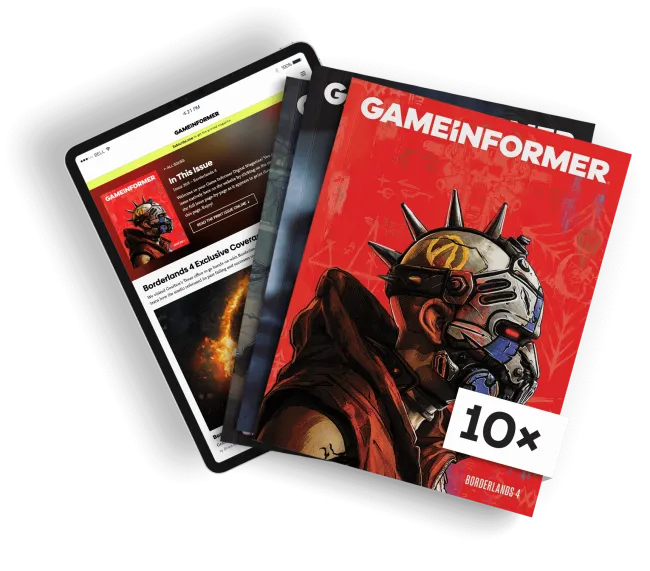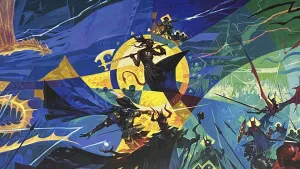Our extra-large special edition is here. Subscribe today and receive the 25% longer issue at no extra cost!
Looking Toward The Horizon

For publishers and developers, it used to be so much simpler. You selected your target platforms, created the games, and released them to brick and mortar retail stores. But in today’s landscape, where new platforms are constantly emerging, digital distribution has opened up new revenue models, and developers don’t even need a publishing partner to get their games made, the number of choices is downright dizzying. Do you stick to the tried-and-true consoles, or do you forgo them altogether to pursue the much larger install bases on mobile phones and tablets? Do you stick with a traditional price model, or test the waters with free-to-play or paid alpha programs? What is one to make of emerging, unconventional platforms with intriguing potential like virtual reality headsets?
To gain a better sense of where the businessmen and creative minds behind the games we love are at, we pulled several of them aside at the annual D.I.C.E. Summit in Las Vegas to hear their thoughts on some of the bigger questions facing the game industry.
Editor's note: This article originally appeared in the April 2014 issue of Game Informer.

Will this new console generation have more or fewer new IP than the previous one?
When Sony and Microsoft launched the PlayStation 3 and Xbox 360, publishers came out of the gate with an avalanche of new franchises. Over the first three years of the consoles, gamers were inundated with bold new concepts, from legitimate blockbusters like Assassin’s Creed and Uncharted to critical darlings like BioShock and Portal. But as the years dragged on and mid-tier publishers like THQ started biting the dust, publishers began relying on established franchises rather than pushing innovation with new games.
With two new consoles offering developers untapped power, we expect creativity to pick up again in the early years of the PlayStation 4 and Xbox One. But will we see the depth of bold new ideas that we enjoyed last generation, or will market conditions dictate that major publishers take fewer chances with their lineups?
“I think you’re going to see the same thing you’ve seen before as far as the AAA space where initially you’re going to see a lot of new IP, and then it’s going to slow down drastically as the generation continues,” says Naughty Dog creative director Neil Druckmann. “The successful ones will stay, and maybe if a few fail then you might see a couple new ones, but it won’t change a lot toward the end.”
Naughty Dog game director Bruce Straley thinks that the steep financial investments attached to large-scale game development makes it tough for publishers to take as many chances as they did in the past.
“The triple-A [publishers] still have the issue of the budgets – they have to create that scale of game versus the profit they have to turn around to justify that dev-elopment again,” Straley says. “We have a luxury at Naughty Dog that Sony trusts us and we’re able to push and challenge ourselves in what kind of games we want to make. But my understanding – and I don’t know because I’ve worked at Naughty Dog forever – is it doesn’t sound like other people really have that kind of flexibility. That will be interesting and definitely affect whether or not you will see more sequels or new IPs – whether or not the upper management of those companies feel comfortable in trying and testing new ideas. Maybe that comes down to scope of game. Maybe if the scope is reduced down they can justify smaller teams, smaller development cycles, and getting something out the door a little bit faster [when] there’s not as much at stake. So maybe it’s not about new IPs, it’s about new scoping of games.”
With both Sony and Microsoft making inroads to creating more inviting platforms for non-established developers to release their games on the consoles, some creators think that – even if we see less new IP from the big publishers – a new era of innovation could spring from these smaller teams.
“One thing that’s interesting right now is there are indie developers that had their first big hit last generation like Braid or Bastion, and they’re making their follow-up games now, and almost none of it is like Braid 2 or Bastion Returns,” says The Fullbright Company co-founder Steve Gaynor. “They are creating new IPs to follow their successes. Obviously, there’s still going to be continuations; there will be more Mass Effects. At the same time, year-over-year, there will be more new prominent IPs that are going to come out.”
Read on to find out what people think of free-to-play invading consoles.

Can the free-to-play economic model gain widespread acceptance on consoles?
Over the past few years, more and more publishers have experimented and found success with new economic models for digital games on PC and mobile platforms. Success stories like Supercell, which generates roughly $2.4 million per day from just two games – Clash of Clans and Hay Day – are spurring the old guard to think about packaging their games in new ways instead of simply sticking a $60 pricetag on each game.
With Blacklight: Retribution, Warframe, and DC Universe Online already testing console gamers’ appetites for these types of experiences on the PlayStation 4, the tide for free-to-play is rising. Whether or not this approach will take hold on consoles is still a charged topic of debate within the industry. Some believe the change is inevitable.
“The numbers are very clear – the old models are continuing to decline,” says EA founder Trip Hawkins.
While any bottom-line oriented businessmen can’t help but think this is the future given the massive success stories, many of the developers we talked to were less convinced.
“There need to be some new methods created in the game design to support it because it feels like nearly all free-to-play games are the same core model re-skinned and reused again and again,” says Media Molecule’s Rex Crowle. “I do not enjoy playing them myself at all because for me it’s always been about investing in the game, and if it’s great you are getting more value for your money and you enjoy it more. It’s noble. Whereas with that model it’s like the more you are enjoying it, the more it costs you.”
Naughty Dog’s Bruce Straley is wary of the model as well.
“I’m not a huge fan of freemium, what that means to players, maybe where that takes games, and more specifically what that means for single-player, narrative based games,” Straley says. “I hope that never becomes a hindrance to us and the kind of games we like making. I’m a little fearful of that.”
Making such a drastic change to a valuable, moneymaking franchise is a daunting task. Games where the majority of their users play online, like Call of Duty and Battlefield, seem to be natural candidates for conversion to freemium, but doing so could endanger their standing with the current fan bases. EA Studios executive vice president Patrick Söderlund told MCV this past November that he doesn’t anticipate flagship EA franchises to wholly adopt a free-to-play model any time soon. “When I pay $60 for Battlefield, I know what I am getting,” he said. “And I think there are players that prefer that. And it’s not a case of one or another; they can both exist, and there may be hybrids, too.”
Their hesitancy could open the door for a competitor to make a bold move.
“It’s hard to detach from $60 until you’re really sure you’re going to come out ahead,” says Trip Hawkins. “Take World of Warcraft – they run a subscription model. It’s not as potent in the MMO market as free-to-play with virtual goods. Blizzard made the mistake of waiting too long and having competitors do it to them instead of them disrupting themselves. I saw a list recently of the most lucrative games and Warcraft was number seven. It used to be a really dominant number one. Everything ahead of Warcraft is free-to-play with virtual goods. They kind of blew that window.
“So when does it happen with a Call of Duty type game? Maybe it will happen with a disrupter. Then they’ll say, ‘We’re losing that $60 anyway because nobody is playing the game, I guess if you can’t beat ’em you better join ’em.’ But the smart guys just finally say ‘Screw it, let’s take the risk, let’s make the commitment, let’s make shift and just believe in it.’ It’s just hard for people who have an established interest to let go of what they have. You can tell that all the big companies continue to struggle. They have a hard time trying to pry their hands off the old way of thinking. It’s human nature; I can see why it’s so difficult.”
The most likely scenario is full-priced blockbusters, cheaper downloadable games, and free-to-play titles will find room to co-exist on the new consoles.
“The good thing about digital distribution taking off and moving away from just buying boxed games at a retailer is it affords for all kinds of different games,” says Naughty Dog’s Neil Druckmann. “Different game lengths, different kind of pricing models for games, and that’s good for gamers because you can allow all these creators who gravitate to different experiences to get it directly to the fans. Yes, because of that you will see more freemium games taking off, but hopefully that’s balanced with the big AAA experience, with smaller indie games – that they all can be successful in this market.”
Up next we discuss how Steam machines may or may not disrupt the PC market.

Will Steam Machines seriously disrupt the PC market?
Valve finally revealed the first lineup of Steam Machines at this past CES, and many were left scratching their heads at the strategy. Introducing 14 different consoles ranging from $500 to upwards of $6,000 gives consumers a lot of choice, but it also could potentially create confusion around the platform. Why spend all that money for a system that has a much smaller game library than the Windows-based Steam?
“That’s one machine I don’t quite get yet,” says Ed Fries, the former vice president of game publishing at Microsoft. “When I’ve talked to Gabe [Newell] about it or heard Gabe talk about it, [Steam Machine] was done sort of as a defensive measure against a fear that [Microsoft] would close down the Windows platform in kind of the same way Apple has to some degree closed their platform. They didn’t close the Mac, but their portable devices are closed. It’s kind of a hedge against that. As a strategy, it makes sense. As a consumer point of view, I have a Windows machine and I have Steam. I don’t need this box.”
The majority of developers we spoke with shared Fries’ sentiments.
“I’m kind of skeptical just because there are 14 of them coming,” says Media Molecule’s creative lead Rex Crowle. “It just feels a bit like 3DO or some other systems that really didn’t quite work out.”
But even though many don’t understand what need the Steam Machines are potentially filling, not everyone is ready to outright dismiss Valve’s endeavor.
“It’s sort of hard to really predict where it’s going to go,” says CCP CEO Hilmar Veigar Petursson. “I’m not sure we need another console. It seems it will have to be very expensive to even compete with a PlayStation 4 with its crazy memory architecture and all that. And they backed away from the crazy controller. I just don’t know. But what I know is it’s going to become something. Valve has a thing in their head, and nobody knows where it’s really going to go.”
Next topic on the docket – second screen gaming's role moving forward.

Can second-screen gaming be anything more than a marketing gimmick?
With the proliferation of mobile and tablet devices over the last several years, more and more studios are brainstorming ideas that allow gamers to use their other devices while playing console or PC games. Battlefield 4’s second screen app allows you to tweak loadouts mid-match or assume the role of commander. Ubisoft’s upcoming open-world shooter The Division also leverages the second screen to give a player control of a drone, working in tandem with his or her friends playing on console.
These concepts are certainly interesting, but ultimately seem more like a back-of-the-box bullet point than a game-changing feature. We asked other developers what they thought of this concept. Some find it very intriguing.
“I’m quite interested in it because to me we have to remove some user interface from the screen,” says Media Molecule designer Christophe Villedieu. “I never like blinking things when I’m playing. I love games when there is no UI at all and you’re trying to guess what’s happening. It depends on the game, because some games you can’t take your eyes off the screen or you’re dead. I think it’s something new – we haven’t explored it yet. I think that’s a new way of playing.”
While the concept holds potential, the fact that you need a player who owns the console to have another device could limit the effectiveness of this approach.
“To have this additional experience you need to have mobile or tablet hardware, and that’s great and everything, but that means that by its very nature, it’s going to be an optional feature,” says The Fullbright Company’s Steve Gaynor. “If your feature is optional, there’s only so much of an impact it will have on the overall design.”
Naughty Dog’s Bruce Straley agrees that there hasn’t been a compelling use of the second screen yet.
“Everything I’ve seen so far – maybe I haven’t seen enough of those games – has been a little gimmicky,” he says. “I think it’s going to take someone to find a feature that really has depth. The problem is if it’s always this optional thing, then no one is going to invest resources into making it integral to the experience. If it’s not integral, then you ask, ‘Well why do I have it at all if it’s just optional?’ Maybe it will take someone who makes it integral – you have to have the second screen and then people will see the value in that, and then really invest and find a feature that’s worthwhile.”
Read on to find out what developers think about pre-paid alphas coming to consoles.

Will major publishers adopt the paid alpha model espoused by indie developers?
Notch first started making Minecraft in his free time, and he didn’t have a lot of money to support the project. Instead of seeking out a publisher or venture capital like many developers do, he took a new approach by opening up the game to the public and charging for access to the alpha. Even though the game still had years of development to go, curious gamers flocked to the world building game, making it a runaway success well before its “official” launch in 2011.
Given the extreme criticism a game like Battlefield 4 received after having a rough launch, it’s hard to imagine major publishers opening up early versions of its games to the public and charging for access. But looking at the Steam top sellers chart, several alpha titles like DayZ, Rust, and Starbound constantly rank in the top 10. Clearly a market exists for games that are a little rough around the edges.
“I can’t imagine that platform holders and publishers are not looking at the success of things like the DayZ alpha,” says the Fullbright Company’s Steve Gaynor. “That was alpha, alpha, alpha, yet it was the top seller throughout the entire Steam holiday sale at full price over all of the games that were discounted. They made money, and their game isn’t going to be at 1.0 for a long time.
“In some ways, that’s been the model for MMOs for a long time. When did World of Warcraft hit 1.0? Its experience is very different three years after release than it was on release. They continue to refine it, change things, and add features, yet they are making money the entire time. Again, it seems like something that with these consoles that are always connected, there’s not a huge reason that we can’t have downloadable games from the PlayStation Store that have a flag on it that says ‘Hey, this is an alpha.’ Maybe it’s discounted or maybe it’s not. I don’t see a reason why it couldn’t work in the same way it works on Steam.”
The market clearly exists for these types of games, but to some developers, the concern about this approach goes beyond the business model. Introducing players to your world early on and receiving feedback could affect the rest of the development – for better or worse. This could be a double-edged sword for products that already have a clear vision.
“I think as a developer it’s quite risky because sometimes you can end up with a different game if you show the game to anybody,” says Media Molecule’s Christophe Villedieu. “Is it better? I don’t know. I think it’s sharing the experience with the players and fans. The sharing aspect I like. We have a strong community with LittleBigPlanet who support us, but do we want them to have tons of input in the next thing? It’s a tricky thing. Sometimes you want it both ways, sometimes you don’t. There are already some betas on consoles, but alphas are a bit too [rough].”
Even if publishers and developers are keen to adopt the paid alpha approach to game design, it’s still ultimately up to the platform holders whether or not they want to allow these types of experiences on their consoles. Microsoft and Sony have traditionally had closed platforms with quality control, and alphas cut against the grain of that philosophy.
“This is a bigger conversation than [Naughty Dog], but if I were in some room with a bunch of dudes talking about what the projections are for what our culture is that we’re trying to create for the platform, do I want to create this sort of open-ended feeling [that] the community is integral and part of this iteration loop, or am I trying to say when you get a game on this console it is the best f---ing game you’re going to get?” asks Naughty Dog’s Bruce Straley. “It needs to be polished and it’s well executed and only certain games are even going to make it on this console – where are the boundaries, where is the line that you draw that says good enough?”
This is a question we’re likely to see answered by Sony and Microsoft in the next few years as PC games and mobile games continue to push the paid alpha model forward.
Last but not least, we turn our attention toward virtual reality.

Will VR headsets go mainstream or are they destined to be niche devices?
The momentum behind virtual reality has steadily increased over the past few years. Sony is working on its own VR headset, Valve was actively exploring the potential, and Oculus Rift continues to grow supporters from within the industry. In the past six months, it lured legendary game developer John Carmack away from id Software to become its chief technology officer and brought on former EA Partners chief David DeMartini to spearhead the company’s publishing division. Internal expectations are incredibly high, with Oculus founder Palmer Luckey boldly proclaiming that VR headsets will go down as “one of the most important technologies in the history of mankind.”
But even with all the hype, several questions still surround the device. How much will it cost once it launches, will Oculus be able to procure a must-play game that will serve as a system seller, and will the install base grow large enough to attract more developers? All of these questions need to be addressed if Oculus wants to move beyond being a niche device and tread into the mainstream consciousness. Several technological hurdles need to be overcome, as well.
“I think it’s going to be a long time before you get the framerate and the quality of graphics up so that it could become a truly accessible device for mass market appeal,” says Naughty Dog’s Bruce Straley. “On the indie side of things there is a huge desire to make something for the VR headsets, and I am extraordinarily intrigued by the possibilities. We’ve talked about, ‘Could you imagine being in Pittsburgh in The Last of Us with the headset on and listening for a clicker or overhearing conversations?’ It would be the most intense experience ever.”
Another potential deflating issue facing virtual reality headsets is the user experience. People who wear glasses don’t have a comfortable experience wearing a headset on top of their frames, and users being subjected to motion sickness isn’t an easy challenge to overcome.
“I’m still in the skeptical camp on that one,” says Ed Fries.“ I’ve only seen the low-resolution version of Oculus and felt sick pretty quickly. I had a lot of technical issues with it. It was hard for me to see past that. I hear the HD version is better, and the motion blur is better. Even with all of that stuff – and I’m probably wrong on this – but trying it made me see all of the problems with it. You can’t really use your head turning to navigate, because your head only goes half way. So you have to have a controller anyway to get around. You’re using your thumbs to get around, not your head, and so your body feels like it’s moving one way and it’s not moving. Your head seems like it’s moving, and that’s what makes you sick. I don’t know how they get around that. No matter what, if you’re going to move, you’re body is not going to be moving. Your inner ear is not going to be moving, but your character will feel like he is moving. Making it so real amplifies the problem. If you can’t move, that’s a fundamental problem.”
Pairing a VR headset with haptic feedback could be one way around this problem, but that type of experience isn’t very conducive to a home environment filled with obstacles like couches, coffee tables, and lamps. In an era where experiences like the Nintendo Wii and Guitar Hero have brought more people into the fold of gaming, some are also resistant to the idea of going back to a reclusive experience where wearing a headset cuts off your interactions with other people in the room.
“I think the immersion aspect is something new, and if it’s nicely done it could change everything, but I don’t see myself playing with that at home with my wife coming in and looking at me like ‘What the f--- is he doing?’” says Media Molecule’s Christophe Villedieu.
Perhaps the true potential for virtual reality technology isn’t in the home, but rather in the dusty old arcades that players have largely abandoned over the past few decades.
“Maybe this could be the rise of arcades again, of actually going somewhere to put these on,” says Media Molecule’s Rex Crowle. “It becomes more of a social thing then, kind of like going to the gym or something like that where you meet up and all put your headsets on and accidentally punch each other in the face as you’re flailing around fighting dragons. It may be some kind of weird mash-up between an arcade, a gym, and LARPing.”

Get the Game Informer Print Edition!
Explore your favorite games in premium print format, delivered to your door.
- 10 issues per year
- Only $4.80 per issue
- Full digital magazine archive access
- Since 1991









